
Dallas Morning News: Breaking bones, barriers
Scottish Rite for Children hosted 40 high schoolers as part of an outreach program to expose girls to orthopedic surgery and engineering.

Scottish Rite for Children hosted 40 high schoolers as part of an outreach program to expose girls to orthopedic surgery and engineering.
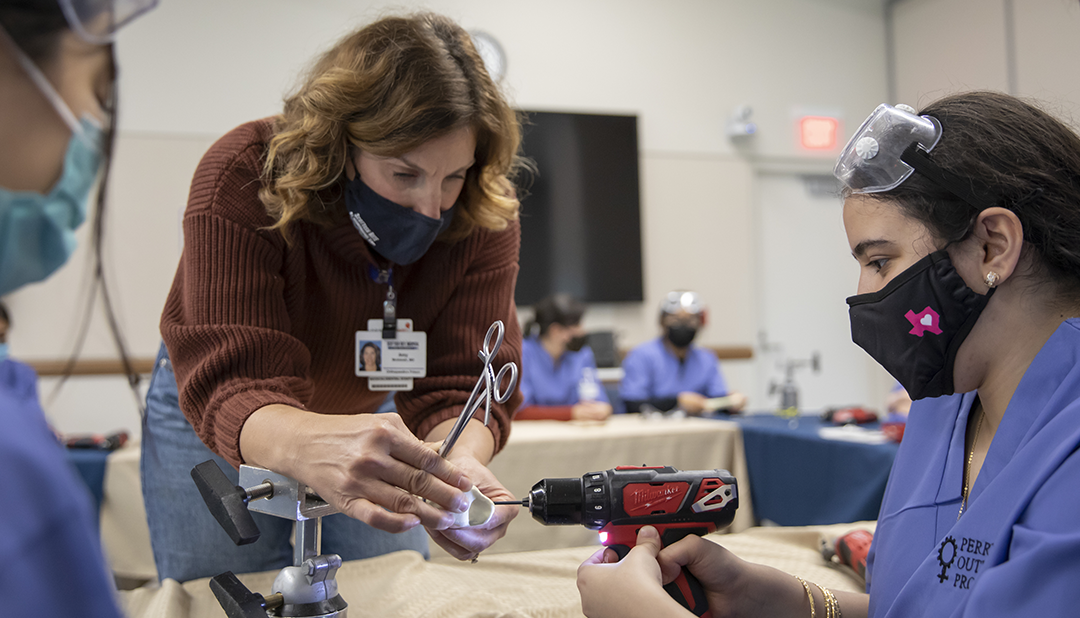
Sounds of whirring drills, buzzing bone saws and clattering trays of suture and casting materials filled the room at Scottish Rite for Children Orthopedic and Sports Medicine Center in Frisco during the recent Perry Outreach Program (POP) course. The daylong course, created by The Perry Initiative, features mentorship as well as hands-on workshops and training designed to introduce young women to aspects of orthopedic surgery and engineering careers, two fields in which women are drastically underrepresented.
Jasmine, former Scottish Rite for Children patient, experienced a light-bulb moment during her POP participation, leading her to study bioinformatics, statistics and biomedical sciences in college. Now a junior at Texas A&M University, Jasmine came back to this year’s POP to help others feel what she felt.
“The empowerment I found through the program encouraged me to continue pursuing my interest in orthopedics rather than being deterred by the underrepresentation of females in the field,” she says. Her POP mentors, Scottish Rite medical director of clinical safety and pediatric orthopedic surgeon Amy L. McIntosh, M.D., along with Kirsten Tulchin-Francis, Ph.D., former division director of Movement Science, led the event in Frisco as local hosts providing guidance and education for 30 young women.
“There are very few women in engineering and orthopedic surgery, so it is essential that young women like these bring their creativity and diversity of thought to these fields,” Tulchin-Francis says. Participants performed mock orthopedic surgeries and conducted biomechanical engineering experiments, while also hearing from prominent women engineers and surgeons in the field.
This course featured suture training on bananas, sawing and drilling synthetic bones and repairing them with plates, screws and surgical devices, and how-tos about applying a cast.
“If I feel intimidated being one of the few females in the field, I remember the joy and empowerment I felt holding that drill,” Jasmine says. “I remind myself daily of the lessons I learned from my mentors to not be afraid to be bold.”
McIntosh encouraged all the young women in attendance. “Be great!” she says. “When you’re the only woman in a room full of men, you shouldn’t try to hide. Instead, use the situation as an opportunity to shine. Be memorable for your hard work, dedication, determination and poise. Speak up with intelligence and confidence.”
“One of my greatest takeaways from the program is to not be afraid to take up the space and make your presence known,” Jasmine says. “You are as deserving to learn as anyone else in the room.” Jasmine was accepted into the Joint Admissions Medical Program (JAMP) in 2021, where she received early provisional acceptance to 11 medical schools in Texas and plans to take the MCAT in April 2022.
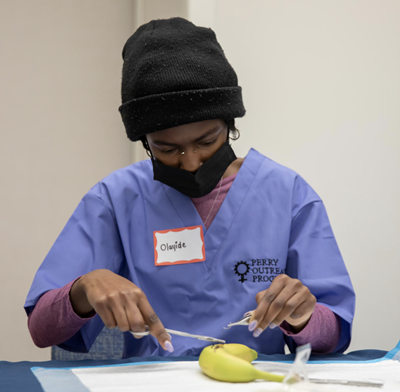
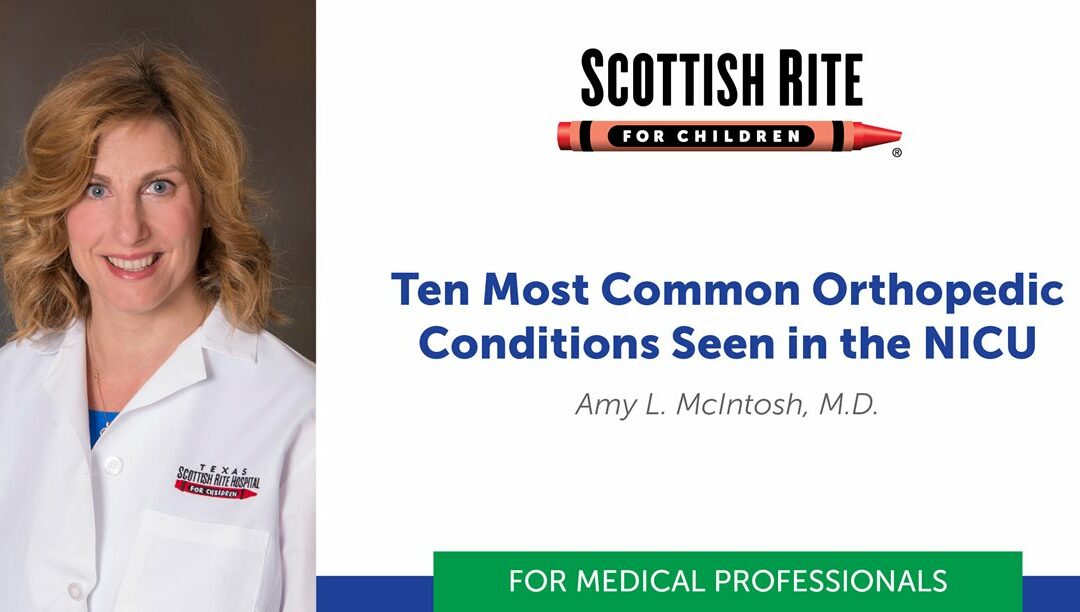
Content included below was presented at the 2021 Pediatric Orthopedic Education Symposium by pediatric orthopedic surgeon Amy L. McIntosh, M.D.
Watch the full lecture or download this summary.
Newborn care, particularly in the neonatal intensive care unit (NICU) requires the consultation of many pediatric specialists. Scottish Rite for Children pediatric orthopedic surgeon Amy L. McIntosh, M.D., frequently consults in the NICU, and in a lecture for pediatricians and other health care providers, she summarized the ten most common conditions she evaluates in newborns.
Pseudoparalysis
A baby with pseudoparalysis typically presents with one arm laying or hanging limply. In many cases, the hand of the affected limb moves normally and the baby can successfully grasp and release the fingers and thumb.
A mechanical injury, typically during birth, causes the apparent paralysis. These factors may contribute to pseudoparalysis:
The most common causes for pseudoparalysis are:
Fracture to the clavicle or humerus
Though alarming to the parents, these causes of pseudoparalysis typically have excellent outcomes. Treatment is focused on immobilizing the arm and keeping the child comfortable, and follow-up care is minimal. In fact, repeating X-rays in follow-up is unnecessary and not recommended.
The treatment instructions are simple. Put the baby in a long-sleeved onesie and safety pin the sleeve to the torso of the onesie for two weeks. This is the easiest way to immobilize the arm. Tylenol may be given to the baby for any pain.
Injury to the Brachial Plexus
The brachial plexus provides motor control in the arm and fingers. Stretching or tearing of a portion of these nerves can cause true paralysis. The child’s wrist and fingers are held in flexion, and there is no active extension with them. When diagnosed, a pediatric hand specialist will often recommend occupational therapy to teach the parents arm, wrist and finger exercises. Observation for nerve recovery and continued care with a pediatric orthopedic hand/upper extremity specialist is highly recommended.
Developmental Dysplasia of the Hip (DDH)
Developmental dysplasia of the hip (DDH) is an orthopedic condition in which the hip joint is unstable or has a shallow socket. There are several risk factors to consider at the beginning of the consultation including:
During the exam, a Barlow maneuver will replicate the hip dislocation, and an Ortolani maneuver moves the femoral head back into the socket. To visualize the condition of the joint surfaces and shape, ultrasound is used to aid in treatment planning. The treatment for DDH is to position the hips in a “frog leg” posture for 23 hours / day using a Pavlik harness for a period of 6-12 weeks. The earlier treatment begins, the better the outcome. Though treatment is typically successful, annual observation by the pediatric orthopedic specialist is recommended until the patient is 18 years old.
Clubfoot
Clubfoot is a congenital disorder in which the foot is severely turned inward and pointed downward. Clubfoot is often associated with other syndromes, including arthrogryposis and amniotic band syndrome. The majority of clubfeet are easily seen on the prenatal ultrasound that is done at 20-26 weeks gestation. During the prenatal consult, Scottish Rite pediatric orthopedic surgeons explain what clubfoot is and its treatment. The Ponseti method is a series of weekly casts that gently move the foot into the correct position. If the baby is going to be in the NICU for six weeks or more, the entire Ponseti method can be completed in the NICU. Otherwise, treatment can begin after discharge from the NICU.
Amniotic band syndrome (Streeter’s dysplasia)
Amniotic band syndrome is a condition where amniotic bands formed in utero constrict fingers, limbs and other body parts. When clubfoot is related to amniotic band syndrome, it is called Streeter’s dysplasia. Sometimes the constriction from amniotic bands requires the limb to be amputated. To establish a relationship and initiate a prosthetic tolerance program and plan, the pediatric orthopedist collaborates with pediatric prosthetists. At a developmentally appropriate time, a custom prosthesis is created to assist the child in meeting normal developmental milestones on time.
NOT Amniotic band syndrome or compartment syndrome –> Limb Ischemia with dry gangrene and auto-amputation
In extremely rare occasions when intrauterine fetoscopic laser surgery is done to treat twin-to-twin transfusion syndrome (TTTS), a loss of blood supply to the developing extremities may cause ischemia and necrosis of a limb or limbs. In these cases, a pediatric orthopedic surgeon monitors and supports efforts to prevent infection while awaiting an autoamputation to occur. Establishing an early connection with a pediatric prosthetist ensures timely training and care to protect normal developmental progression.
Polydactyly / Syndactyly
Polydactyly is a hereditary condition that causes supernumerary (excess) fingers and/or toes, typically on the medial or lateral side. Syndactyly is a condition that causes two or more digits to be fused together. With preaxial polydactyly, the thumb or great toe (first digit, or medial-sided) is duplicated, which can be associated with tibial dysplasia or a tibial hemimelia. It is important to get X-rays of the tibia, fibula and foot to fully assess for tibial dysplasia. With postaxial polydactyly, the fifth, most lateral digit is duplicated. Postaxial polydactyly is never associated with tibial hemimelia, and it is much easier to treat surgically. Surgery is typically offered at 6 months of age or greater. Referral to a pediatric orthopedic surgeon for a thorough evaluation and discussion of treatment considerations is highly recommended.
Congenital knee dislocation
Congenital knee dislocation (CKD) is often associated with other syndromes, so a genetic consult is indicated. These babies are usually born Frank breech, and some may have required a Cesarean delivery. The knee or knees present in a hyperextended position. Ultrasound should be used to rule out hip dislocations, since the knee and hip are often both affected. CKD is treated with serial casting. A series of long leg plaster casts will slowly reduce the knee joint into a more normal position. Once the knee can be flexed to 90 degrees, a Pavlik harness is used to maintain knee flexion. Treatment can be completed during the NICU stay or as outpatient procedures after discharge.
Calcaneovalgus foot
Unlike a clubfoot, with a calcaneovalgus foot, the calcaneus is dramatically everted and flexed, sometimes the top of the foot is almost touching the tibia. This condition is usually caused by intrauterine positioning. With appropriate stretching, the foot position gradually improves in the first 4 to 6 weeks of life.
There is an association between calcaneovalgus feet and posteromedial bowing of the tibia. When an X-ray of the tibia reveals or confirms a posteromedial bow, the child is very likely to have a leg length discrepancy of 2-5 centimeters. These children should be referred to a pediatric orthopedic specialist with experience in limb reconstruction to monitor, and if needed, address the leg length discrepancy caused by the tibia bowing prior to skeletal maturity.
Spinal dysraphism
Spinal dysraphism is a reference to congenital abnormalities in the vertebrae, spinal cord and/or nerve roots. These signs are commonly associated with underlying spinal abnormality:
These cutaneous manifestations are all significant hints that the underlying spinal cord or vertebrae did not form normally. An MRI of the spine is required to determine the exact nature of the spinal dysraphism. Possible definitive diagnoses include tethered cord, abnormal development of the spinal cord, lipomeningocele or spina bifida. Referral to a pediatric orthopedic specialist with experience in neurological and spine conditions is highly recommended. The child will need ongoing evaluation and intervention to maximize function with spine and limb deformities with growth.
Addressing positioning, postural and orthopedic concerns may not be a top priority in the early days, but consulting a pediatric orthopedic specialist should be considered as soon as the need is identified. A collaborative approach to prioritizing care with treatment plans and accurate information is beneficial for treatment outcomes and reassuring to the family.
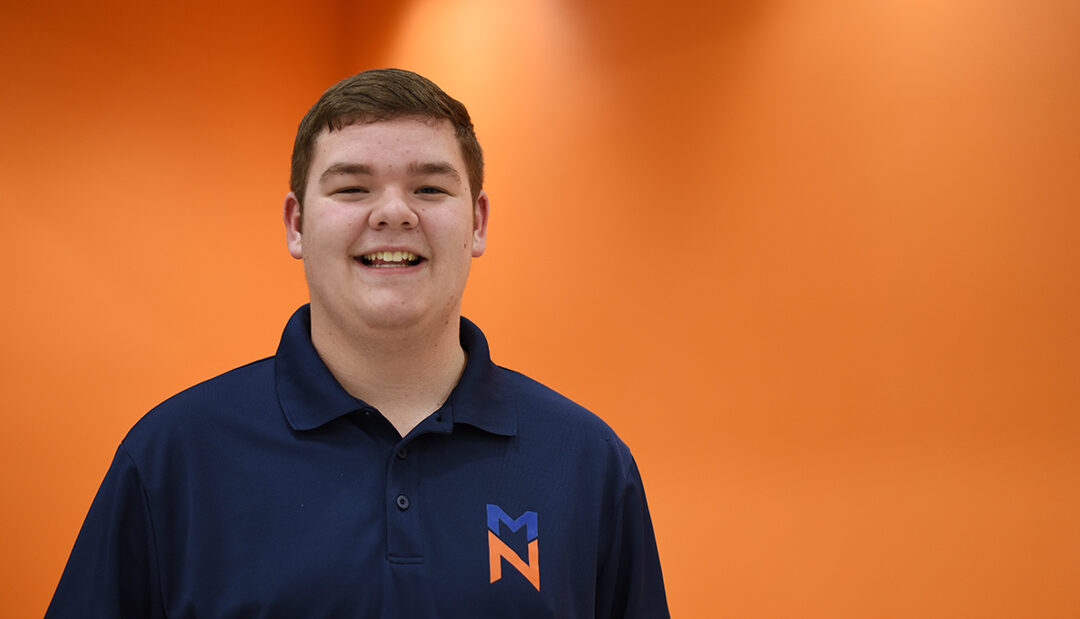
Cover story previously published in Rite Up, 2021 – Issue 1.
by Hayley Hair
The rhythm, the tempo, and the heartbeat — all fitting descriptors for the function of a band’s percussion section, but using an even more compelling name like the backbone depicts their role more succinctly. Just like a spine, all those sharp pops of the quad drums, the satisfying crashes of the cymbals, and the low, palpable rumbles of the bass drums provide stability, support, flexibility, and movement to the ensemble. No one knows this juxtaposition more personally than Luke, the McKinney North High School bass drum percussionist and Scottish Rite for Children patient cared for by our scoliosis experts.
Plenty can be learned about adolescent idiopathic scoliosis (AIS) by following Luke’s journey. AIS, or scoliosis with an unknown cause starting after age 10, makes the spine curve or twist into a “C” or “S” shape. Luke’s personal experience covers the broad spectrum of how the progressive condition is diagnosed, observed, and expertly managed with an individualized treatment plan.
“Luke’s pediatrician identified the minor curvature of his spine and uneven shoulders at his 9-year-old well visit,” Luke’s mom, Christy, says about the outset. “The pediatrician immediately referred us to Scottish Rite, and the initial plan was to monitor Luke every six months to identify any changes that may occur.”
Scoliosis Observation and Expertise
Luke and Christy’s first visit at Scottish Rite for Children was with Amy L. McIntosh, M.D., medical director of clinical safety and a pediatric orthopedic surgeon. “I think that’s one of the greatest things about Scottish Rite — we have so many treatment options for scoliosis,” McIntosh says about the expertise and exceptional care the institution offers.
Clinical observation might not seem like much of an active plan at first, but consistent monitoring of the child’s growth is key. Catching any progression in spine curvature is crucial for effectively managing scoliosis. Christy, a registered nurse, is the coordinator of health services for McKinney Independent School District, which serves more than 23,000 students in North Texas. She has experience with AIS through her work with state-mandated scoliosis screenings in school as well as training other health professionals about the condition, so McIntosh and Christy are on the same page about early detection. “Scoliosis screening is very important.” McIntosh says. “Catching a curve early, when it is small, is the most important factor when it relates to brace treatment success.”
A Brace Just for Luke
As Luke continued to grow, unfortunately, so did his curve. McIntosh first prescribed a Providence brace, or a nighttime brace made for smaller curves, for Luke to wear while he slept that would help to slow his curve progression. “I thought it would just go away like a sickness, like braces for your teeth,” Luke says.
His new brace, along with all of Scottish Rite patients’ braces, is custom-made for his curve. “The coolest thing about our bracing program is that the orthotists work at Scottish Rite, and they make all the braces in-house,” McIntosh says. “If you are going to wear a brace, it might as well work really well for you.”
And during each patient’s clinic visit, the multidisciplinary care team specific to the child’s condition is nearby. “We have the orthotists with us, the nursing team, physicians, the physical and occupational therapists — everybody’s ready on hand in the clinic to provide the best comprehensive care for each patient,” Chief of Staff Daniel J. Sucato, M.D., M.S., says. As director of the Sarah M. and Charles E. Seay/Martha and Pat Beard Center for Excellence in Spine Research, Sucato leads an institution-wide team that focuses on researching the cause and behavior of scoliosis in children and adolescents and controlling and correcting curve progression with innovative treatments.
More Hours in the Brace
As Luke kept growing, again, so did his curve. McIntosh had more in her arsenal and upped his support to a custom thoracolumbosacral orthosis (TLSO) brace. Made for wear under clothing day and night, the TLSO brace wraps around the upper body from under the arms to the pelvic bone. Luke’s curve affected both the upper, or thoracic, and the lower, or lumbar, regions, creating a twisted “S” shape.
Patients, like Luke, wear their braces for 18 to 24 months for many hours a day. That timing is determined by the age at presentation, the curve magnitude, and how much growth remains. “Currently, the brace is the only treatment that has been scientifically proven to prevent the progression of scoliosis to a surgical magnitude,” McIntosh says.
Correcting Scoliosis with Surgery
“He wore his brace until the ninth grade, and he was so compliant,” Christy says. “He even tried to wear the brace while he was in marching band while carrying the bass drum, but he couldn’t. It was too much, so he started taking it off for band.”
Luke literally and metaphorically carries the beat on his back while he zigs and zags across the football field holding his enormous bass drum. Fastened to a frame that hooks over both shoulders, the drum weighs more than 20 pounds and juts out far enough to move when the wind blows. Luke loves to be a part of the drumline, and when asked if he plans to continue studying music in college, he replies, “100 percent.” Some of his best friends are in the band. “It’s a great way to meet people, and I’ve made close friends that will probably last quite a while,” Luke says.
Luke wore his brace up to 22 hours a day, but his curve kept progressing. When his curve grew to more than 50 degrees, surgical correction was recommended. Luke experienced some discomfort and breathing difficulty as well. “When it was really bad, like after band practice, after marching out there with my drum for a while, it just hurt,” Luke says. “I tried to get Luke’s spine through it as best as I could, X-ray before surgery but sometimes I’d have to sit out and do stretches. It wasn’t bad to the point where I couldn’t do anything, but it was just constant.”
Getting ready for surgery, Luke looked to McIntosh to explain the next steps. “She gave me a 3-D model of what the surgery would look like on my back,” Luke says. “I got to play with it and bend it to see the difference between a normal back and a back with spinal fusion. It made me feel better.”
Luke had a posterior spinal fusion with instrumentation and bone grafting, the most common scoliosis surgical procedure. By attaching rods to the spinal column and then grafting bone to the affected area, the spinal curve is corrected and encouraged to fuse to prevent further curve progression. Following surgery, the fused section is no longer flexible.
Recovery takes several months for patients to get back to their desired activities, and it takes up to a year for the spinal fusion to fully heal. During Luke’s recovery, the drumline and their teacher, Michael Reed, brought a huge card signed by everyone with well wishes during a visit to his house.
After years of wearing a brace and surgery, Luke has advice for others going through bracing and surgery for scoliosis. “If they are going through bracing, I’d tell them to wear their brace as much as possible to try to avoid the surgery,” Luke says. “If they are about to get into the surgery, don’t worry about it too much. They are professionals, and they know what they are doing.”
Luke gained a few inches in height and has no more pain following surgical correction. “It is a lot easier to do stuff with my back like this,” Luke says. Even though there are reminders each day about his spinal fusion, he says he wouldn’t change a thing about his treatment at Scottish Rite for Children. “You are in the best hands,” he says. “They know exactly what to do.”
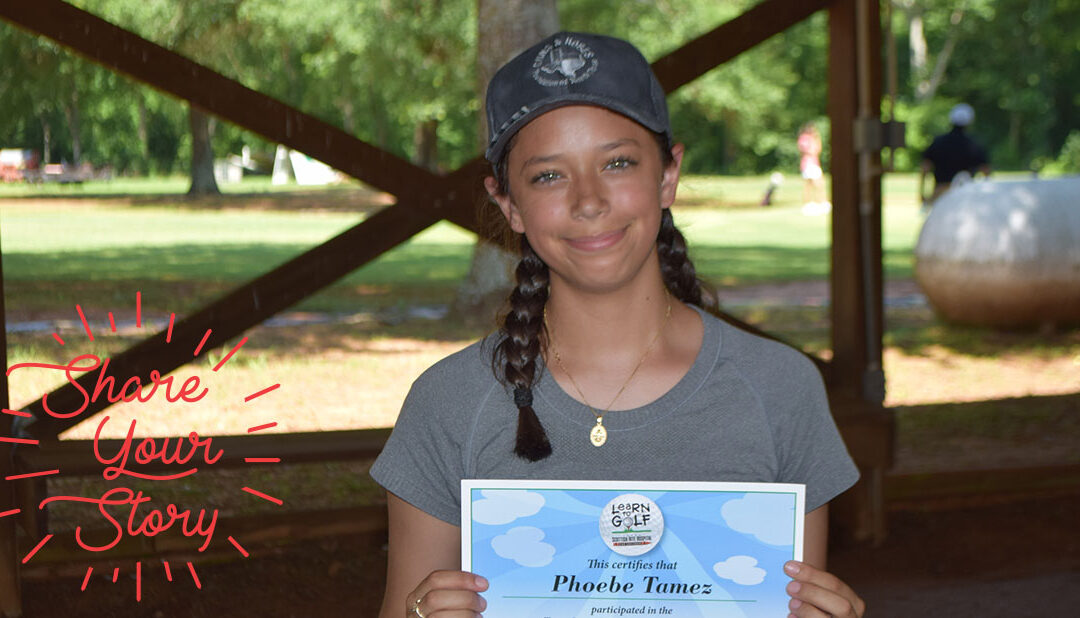
Meet Phoebe, a patient seen by our spine experts. Learn more about her journey below.
Blog written by Phoebe’s mom, Victoria of Rockwall, TX.
When Phoebe was in sixth grade, she had her annual pediatrician visit and that was when our doctor first recommended further evaluation of her back. Phoebe’s shoulders were uneven, and she appeared to have an abnormal spinal curve. Our pediatrician recommended that we go to Scottish Rite for Children.
Phoebe became Dr. McIntosh’s patient and due to the degree of curvature in Phoebe’s spine, a scoliosis back brace was highly recommended and necessary to stop the progression of the curve. As a mother of a beautiful, young and active daughter, the news was a hard pill to swallow. We were very nervous and afraid of how the brace was going to impact our daughter’s lifestyle. Dr. McIntosh was very understanding and thorough, answered all our questions and made us, especially Phoebe, feel comfortable.
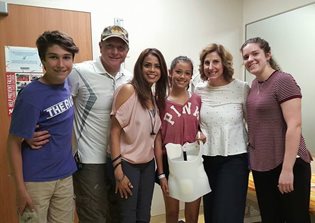
That same day, we met with Kelsey in the Prosthetics department. She took measurements and designed Phoebe’s back brace. Phoebe loved all the staff and doctors but felt a special connection with Kelsey. She was funny, young at heart and spent a lot of time with Phoebe during the brace adjustments.
At that time, Phoebe was 11 years old and about to transition from elementary to middle school. It was hard to see her wear a thick plastic brace during the hot 100+ degree weather. Phoebe has always been tough, and she rarely complained. She didn’t like the brace, but she knew that it was the only option to stop the curvature progression. Many times, she would even wear it for more than the 20 hours a day that was recommended. She started with a 19-degree curvature and at the end of the process, she was at a 17-degree curvature, which was great.

As a family, we did different activities together and allowed Phoebe to try many different sports. Phoebe was able to play soccer and basketball, run track, and even participated in cheerleading – all throughout her bracing process. Dana Dempsey, the Scottish Rite Director of Therapeutic Recreation, invited us to participate in a Learn to Golf clinic. It was at this clinic when Phoebe decided to try golf and she fell in love with the sport! Through the years, she has participated in several different Learn to Golf clinics and is now on the varsity golf team at her high school. She even made the varsity team as a freshman!
We are beyond grateful for all of the staff and volunteers at Scottish Rite. Phoebe’s scoliosis experience was much brighter due to the care and love she felt, and we strongly recommend Scottish Rite to anyone else that may be going down this path.
Learn more about Phoebe’s Story and see how Learn to Golf changed her life. Click here.
DO YOU HAVE A STORY? WE WANT TO HEAR IT! SHARE YOUR STORY WITH US.